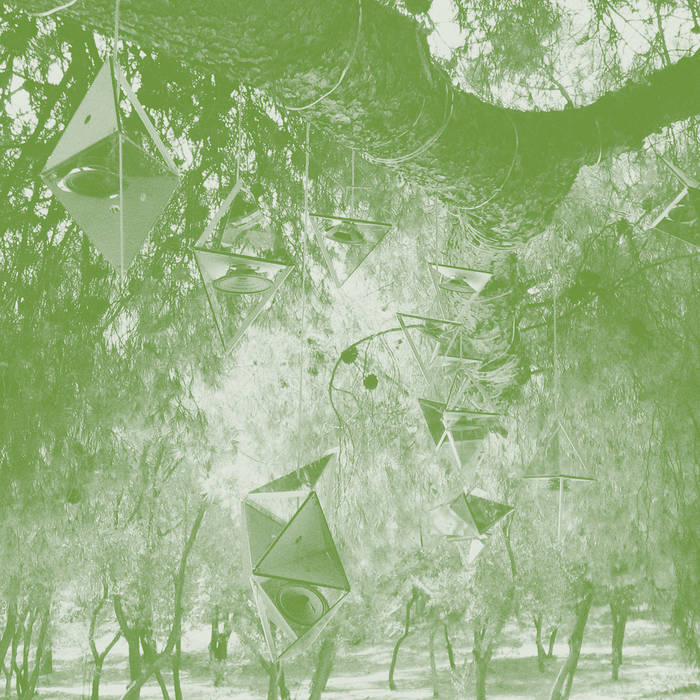 I am thrilled that Room40 is digging up and reissuing some woefully underheard gems from Steve Roden these days, as a hell of a lot of fascinating work passed me by in the pre-Bandcamp days of hyper-limited physical releases. Stars of Ice (due for a reissue in February) was especially revelatory for me, but this more modest initial dispatch from Roden's vaults is quite a treat as well. As far as I know, Oionos has not been released previously, yet it dates from a 2006 exhibition in Athens, Greece entitled The Grand Promenade. The premise of the exhibition was to create a "dialogue" between "contemporary site-specific works" and "various archaeological and historical sites in central Athens," but Roden fell in love with the Church of St. Dimitris Loumbardiardis (not among the planned sites) and managed to talk the curator into allowing an exception. Notably, the architect behind the church was the same man (Dimitris Pikionis) who designed the original promenade, so Roden's selection was a thoughtful and inspired decision, as he felt the path leading to the church provided a "stronger impression of Pikionis's vision" than the actual promenade (unlike the main promenade, the path to the church escaped being ‘restored’ in preparation for the 2004 Olympics).
I am thrilled that Room40 is digging up and reissuing some woefully underheard gems from Steve Roden these days, as a hell of a lot of fascinating work passed me by in the pre-Bandcamp days of hyper-limited physical releases. Stars of Ice (due for a reissue in February) was especially revelatory for me, but this more modest initial dispatch from Roden's vaults is quite a treat as well. As far as I know, Oionos has not been released previously, yet it dates from a 2006 exhibition in Athens, Greece entitled The Grand Promenade. The premise of the exhibition was to create a "dialogue" between "contemporary site-specific works" and "various archaeological and historical sites in central Athens," but Roden fell in love with the Church of St. Dimitris Loumbardiardis (not among the planned sites) and managed to talk the curator into allowing an exception. Notably, the architect behind the church was the same man (Dimitris Pikionis) who designed the original promenade, so Roden's selection was a thoughtful and inspired decision, as he felt the path leading to the church provided a "stronger impression of Pikionis's vision" than the actual promenade (unlike the main promenade, the path to the church escaped being ‘restored’ in preparation for the 2004 Olympics).
Originally constructed in the ninth century using materials salvaged from surrounding ruins and described as "likely the most secluded and serene" of Athen's assortment of Byzantine-era churches, the Church of St. Dimitris Loumbardiardis is remarkably still in use. That presented something of a challenge for Roden, as his installation needed to harmonize with and enhance its peaceful environs without disrupting what made the place so alluring in the first place. He eventually decided to hang his sound installation from a large tree and opted for characteristically Roden-esque lowercase sounds that "could blend with all of the insect noises and the overall quiet of the area.” For his sound sources, Roden chose “field recordings and small ‘poor’ objects such as tin whistles, toy harmonicas, and the like." Significantly, the latter were inspired by a basement display case of "non-instruments" located in Athen's museum of musical instruments, as Roden felt the modest items meshed nicely with Pikionis's interest in blending "indigenous culture" with "intellectual and modern culture." In more concrete terms, Oionos is essentially an hour of gently whirring, whining, and crackling suspended animation. There is also a wandering, disjointed melody that calls to mind either a slowed down recording of wind chimes or a malfunctioning music box that emits sparks and feedback as it strains to produce a fitful melody. I suppose that makes Oionos a very "ambient" piece, but it can also be more than that depending on how attentively I choose to listen: sometimes it feels like fragments of a wrong-speed Andrew Chalk album floating above a rich landscape of subtle, shifting textures, while other times evokes a pleasant sense of unreality, as if submerged ghost melodies struggle to surface from a quiet haze of insectoid whines, burbling water, and gently windblown leaves. It is quite a beautifully realized piece, yet I can understand why it was not released until now, as it lingers in delicate stasis rather than undergoing any kind of significant evolution (an approach far more preferable for an installation than an album intended for home listening). Then again, Steve Roden is hardly an artist known for adhering to convention, so listeners already familiar with his oeuvre will likely enjoy basking in this meditative sound world a great deal. For the merely Roden-curious, there are probably better albums to start with, but Oionos is still strong enough to effectively convey why his work remains so revered in sound art circles.
Samples can be found here.
Read More

